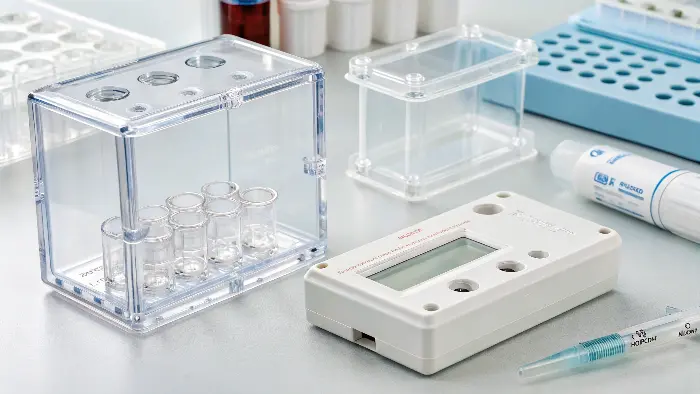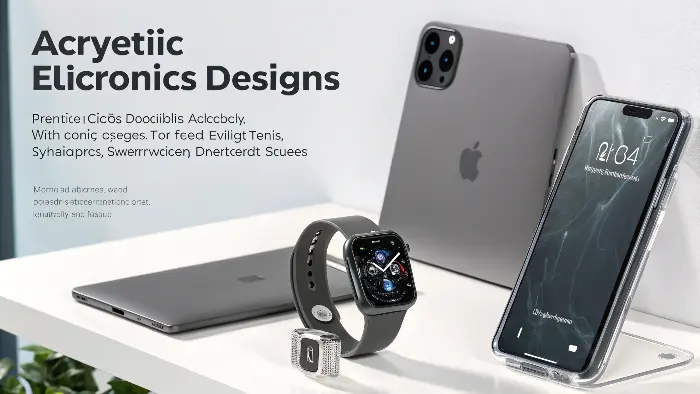Finding the right material is a headache, right? Acrylic offers amazing versatility. CavityMold helps you unlock its full potential for your specific industry needs.
Acrylic (PMMA) is a top choice for automotive, medical, and electronics due to its optical clarity, durability, and design flexibility. It enables innovative solutions like advanced lighting, precise medical tools, and sleek consumer gadgets.
You know, Alex, it’s one thing to talk about a material in theory, but it’s another to see it shine in real-world applications. Acrylic, or Polymethyl Methacrylate if we’re being formal, is one of those materials that just keeps surprising us with its range. At CavityMold, "Master Molding Right" means we really get into the nitty-gritty of why a material like PMMA is chosen for a specific job and how to get the absolute best out of it. It’s not just about melting plastic and squirting it into a mold; it’s about understanding the end-use, the environment, the stresses – everything! I’ve seen PMMA go from simple light covers to incredibly complex optical components. Its clarity is obviously a huge selling point, but there’s more to it than meets the eye – literally! Let’s explore a few key areas where acrylic really makes a difference. It’s always a good day when a challenging PMMA project comes through our doors!
How is Acrylic Revolutionizing Automotive Lighting and Displays?
Old car lights dim and crack; they just don’t cut it anymore. Modern cars need better. Acrylic offers brilliant, durable lighting solutions, transforming vehicle aesthetics and safety.
Acrylic is key in automotive for its superior optics, weather resistance, and ability to form complex light guides and lenses, enhancing both safety and design appeal. It’s lighter than glass, too!
!
When you think about cars, Alex, lighting is a huge deal now – not just for seeing the road, but for style and branding too. And guess what? Acrylic is right there at the forefront. It’s funny, I was driving behind a new EV the other night, and its taillight signature was just mesmerizing – all thanks to cleverly designed PMMA light guides. It’s a far cry from the simple bulb-and-reflector days!
Unmatched Optical Clarity for Headlights and Taillights
First off, PMMA offers fantastic light transmission, often around 92%, which is even better than glass in some cases. This means brighter, more efficient headlights and taillights. Plus, it can be molded into incredibly precise lens shapes to control light beams exactly where they need to go, reducing glare for oncoming drivers and improving visibility. We’re talking complex fresnel lenses, total internal reflection (TIR) optics – all perfectly formed.
Durability and Weather Resistance on the Road
Cars live a tough life – sun, rain, road debris. PMMA stands up pretty well. It has excellent UV resistance, so it doesn’t yellow or become brittle quickly like some other clear plastics might. It also has decent impact strength – maybe not as tough as polycarbonate, but certainly robust enough for most lighting applications and it’s less prone to stress cracking than PC sometimes. We always select specific grades of PMMA that are formulated for automotive exterior use, ensuring they meet all those stringent OEM standards.
Complex Geometries for Innovative Designs
This is where PMMA really shines for automotive designers. Think about those signature daytime running lights (DRLs) or the ambient interior lighting that makes a car’s cabin feel so premium. PMMA can be molded into intricate light pipes and guides that can carry light from a hidden LED source and distribute it evenly along complex curves. I remember working on a project for a luxury car brand – I think I mentioned it before. They wanted this incredibly intricate taillight assembly that looked like a flowing ribbon of light. PMMA was the only way to achieve that with the optical precision they demanded. It was a challenge, especially getting the light distribution perfect without any hot spots, but wow, the final product on the car was just stunning. We had to do so many Moldflow simulations and prototype iterations to get those light guides just right! That’s where our "Master Molding Right" philosophy really comes into play.
Weight Reduction Benefits
And here’s a bonus – PMMA is significantly lighter than glass. In an industry constantly chasing fuel efficiency and performance, every gram counts. Switching from glass to acrylic for large lighting components can contribute to overall vehicle weight reduction. It might seem small, but it all adds up!
Why is Acrylic the Clear Choice for Medical Devices and Diagnostics?
Patient safety is paramount; no cutting corners there. Medical devices need reliable, clear materials. Acrylic often steps up, offering clarity and biocompatibility for critical applications.
Acrylic is vital in medical fields for its excellent optical clarity for diagnostics, biocompatibility for patient contact (specific grades), and good sterilizability. It’s used in cuvettes, test kits, and device housings.

Moving into the medical field, Alex, the stakes are incredibly high. Materials here need to be safe, reliable, and often, very, very clear. Acrylic, particularly certain medical grades, ticks a lot of these boxes. It’s amazing how versatile this material is, going from a flashy car taillight to a life-saving medical component.
Biocompatibility and Sterilization Compatibility
This is a big one. For devices that come into contact with patients or bodily fluids, the material must be biocompatible. There are specific grades of PMMA that meet USP Class VI or ISO 10993 standards. These grades are formulated to be non-toxic and non-irritating. Then there’s sterilization. PMMA can handle common methods like Ethylene Oxide (EtO) and, with some grades, even gamma radiation or E-beam sterilization, though you have to be careful with gamma as it can sometimes cause yellowing or brittleness in standard PMMA. We always work closely with clients to ensure the chosen PMMA grade is compatible with their required sterilization methods. It’s a critical detail!
Superior Optical Properties for Diagnostic Components
Think about cuvettes for blood analyzers, lenses in diagnostic equipment, or windows in medical imaging devices. They all need to be crystal clear for accurate readings. PMMA’s high light transmission and low haze make it perfect for these applications. Its refractive index is also well-characterized, which is important for optical design. We once made a series of microfluidic chips from PMMA for a diagnostics startup. The channels had to be incredibly precise, with an almost mirror finish for the optical readings. Getting the mold polished to that level and ensuring no flash in those tiny channels – that was something else! The tolerances were just mind-boggling. But seeing those chips help with faster disease detection? That’s what makes this job really rewarding, Alex. It’s not just plastic; it’s enabling medical breakthroughs.
Precision and Intricate Designs for Medical Instruments
From drug delivery systems to components for surgical tools, precision is key. PMMA can be injection molded into very complex shapes with tight tolerances. This allows for the creation of intricate features like Luer connectors, small channels, or precise mating surfaces directly in the molded part, reducing assembly steps and potential leak paths.
Chemical Resistance in Medical Environments
Medical devices are often exposed to various cleaning agents and disinfectants. PMMA generally offers good resistance to many common chemicals, like alcohols and some diluted acids and bases. However, it’s not great with strong solvents like ketones or aromatic hydrocarbons, so material selection needs to consider the full chemical exposure environment. It’s always a balance, and we help our clients navigate these choices.
Can Acrylic Bring Your Consumer Electronics Designs to Life with Style and Durability?
Consumers want sleek, durable gadgets; looks matter a lot. Material choice is absolutely key. Acrylic offers a premium look and feel, making products stand out from the crowd.
Yes, acrylic provides consumer electronics with a high-gloss, premium aesthetic, good scratch resistance, and excellent light transmission for screens, light pipes, and indicator lenses, significantly enhancing user experience.

Now, let’s talk about the gadgets we use every day, Alex. Consumer electronics – from smart home devices to audio equipment. Here, aesthetics are king, but durability can’t be ignored either. Acrylic often finds a sweet spot. I’ve seen it transform a functional but boring product into something really eye-catching.
Sleek Aesthetics and Premium Feel
PMMA can be molded to achieve a super high-gloss, almost glass-like finish. Think of those "piano black" surfaces on high-end audio equipment or the crystal-clear fronts of smart displays. This premium look and feel can significantly elevate the perceived value of a product. It just feels more expensive and well-made. We can also achieve vibrant, consistent colors by using pre-colored PMMA resins or masterbatches. It’s funny, a lot of people think ‘plastic’ and they think ‘cheap’. But when you show them a beautifully molded, high-gloss PMMA housing for, say, a high-end speaker or a smart thermostat display, they’re always impressed.
Scratch and Impact Resistance for Everyday Use
While not as tough as polycarbonate, PMMA offers good surface hardness and scratch resistance, especially compared to other clear plastics like polystyrene. For many consumer electronics that aren’t subjected to extreme abuse, it’s perfectly adequate. And for applications needing more, there are scratch-resistant coatings that can be applied to PMMA parts to further enhance their durability. I remember a project for a boutique audio company – they wanted this deep, lustrous black finish for their control panel, with crystal-clear light pipes for the indicators. PMMA nailed it. The feel of it, the look – it just screamed quality. They were a bit worried about scratches initially, but we sourced a grade with an enhanced surface hardness, and it held up beautifully in their drop tests.
Light Transmissive Qualities for Screens and Indicators
Just like in automotive and medical, PMMA’s optical clarity is a huge asset in electronics. It’s used for display screens (especially in older models or as protective overlays), indicator light covers, and light pipes for illuminating buttons or logos. The material can diffuse light nicely with the right additives or surface textures, creating soft, even glows instead of harsh hotspots from LEDs. This detail makes a huge difference in the user experience.
Design Flexibility for Unique Product Forms
PMMA injection molding allows for complex shapes, thin walls, and integrated features like snap-fits or bosses. This gives designers a lot of freedom to create unique and ergonomic product forms that might be difficult or too expensive to achieve with other materials like glass or metal. We’ve made some pretty wild shapes for bespoke electronics enclosures! Sometimes designers come to us with an idea sketched on a napkin – okay, maybe a CAD model these days – and it’s our job to figure out how to make that beautiful, functional PMMA part a reality. That’s the challenge we love at CavityMold.
Conclusion
Acrylic’s versatility shines across industries. From car lights to medical tools and cool gadgets, CavityMold helps you leverage its benefits for innovative, high-quality products. We master molding right!
